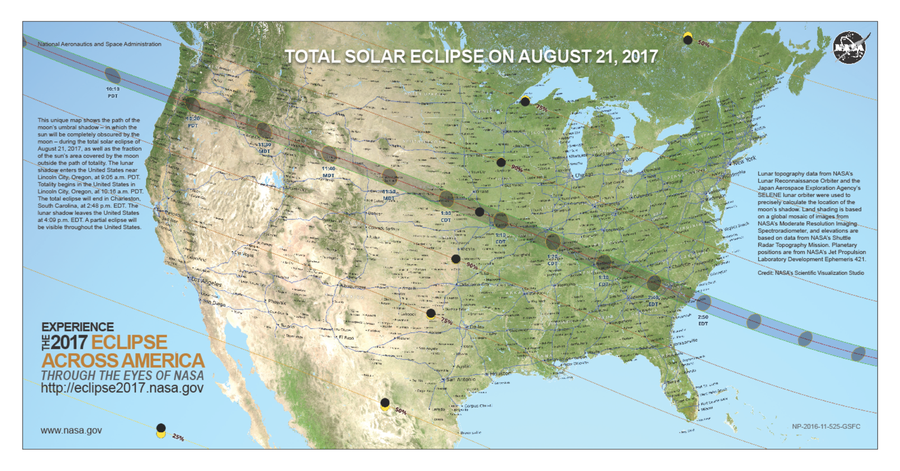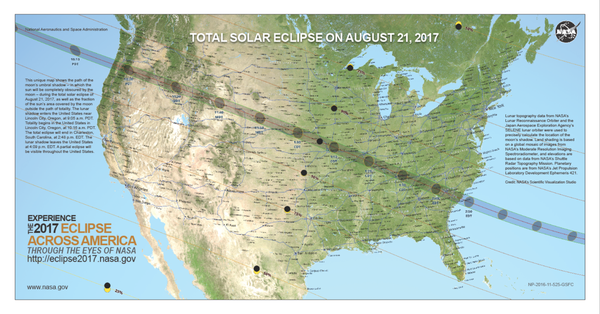This article was published in Scientific American’s former blog network and reflects the views of the author, not necessarily those of Scientific American
Spring has finally arrived despite the confusing weather, and the American Museum of Natural History in New York is hosting a series of events this weekend to “explore eclipses and the phenomena behind Sun-Earth interactions.” Here is a look at the visual perception aspects of the 2017 total solar eclipse—and what the gaze of an artist can bring to the science of vision.
A Spanish version of the article below was originally published by Mente y Cerebro earlier this year.
Total Eclipse of the Mind
On supporting science journalism
If you're enjoying this article, consider supporting our award-winning journalism by subscribing. By purchasing a subscription you are helping to ensure the future of impactful stories about the discoveries and ideas shaping our world today.
By Stephen L. Macknik and Susana Martinez-Conde
Susana hung out the window as the car sped at 120 kph along the Path of Totality. The moon raced back towards us at 1,674 kph, which means we had become an algebraic word problem. Susana steadied her phone camera as best she could—while pointing at the sun through a sunlight-filter over the camera lens. She announced the progression of the eclipse, “It’s three-fourths complete!” We had intended to watch the eclipse from the beach in Charleston, South Carolina. But on that morning of August 21, the sky had been too cloudy, and we didn’t trust it to be clear at showtime. We wanted to ensure that the skies were cloud-free and that we had a direct view of the eclipse: no visual recording device existed that could replace witnessing the event with our own eyes. So we jumped in the car and headed westward along Interstate-26, playing a celestial game of chicken. Our hunt finally came to an end when we met our cosmic prey in Greenville, near South Carolina’s shared border with both Georgia and Tennessee, just after 2pm.
With clear skies, we found ourselves at the Greensville zoo, watching the total eclipse in the company of monkeys. The primates went eerily silent during the totality. Perhaps they too felt the weird atmospheric heaviness around us, or possibly due to the hundreds of nearby humans squealing and hooting as the day plunged into darkness: a strange reversal of roles during a magical moment. It was a transformative experience for all of us, and worth the months of planning necessary to make it happen. But why was it worth it? Wouldn’t it have been sufficient to witness the eclipse from our home, live from our Twitter feeds?

Total Solar Eclipse on August 21. Credit: NASA
What We Saw
There is no equivalent experience to watching a solar eclipse with the naked eye. A video recording of an eclipse is just not the same. The reason is that your visual system remains the most sublime visible-light imaging device in existence, irrespective of modern advances in camera technology. Even so, an eclipse has many levels of brightness to view: 16 orders of magnitude, whereas the human visual system is responsive to only 6 orders of magnitude. This means that even the human eye is unable to appreciate the full range of brightness during an eclipse.
In a total solar eclipse, the moon blocks brightness coming from the photosphere—the intensely luminous surface of the sun, from which the most light radiates—but you are still exposed to the chromosphere—the fiery outer atmosphere enveloping the solar disk at the photosphere’s edge. The chromosphere is so bright that it saturates your retinal photoreceptors, so you cannot distinguish all the variations within it; it looks painfully white to human observers.
Brightness decreases precipitously as a function of distance from the photosphere, allowing human vision to discern the many wonderful eerie variations of brightness within the sun’s extended outer atmosphere, called the “corona.” Five to six orders of magnitude are visible in the wispy and jagged corona. It stretches out far beyond what you can see: most of the coronal brightness variations are too weak for the human eye to detect, and they appear as black as the darkest night.
You can intuit the many levels of brightness in an eclipse—including those above and below the human brightness perception range—with this thought experiment: imagine a dim star from which about 1,300 photons reach your eye every second. Now imagine a second star placed to the right of the first star, with about 13,000 photons arriving to you in the same second. Then add a third star to the right of that, that is another 10 times brighter (130,000 photons/s). And keep adding stars that increase in brightness by 10X until you have 16 stars, each 10 times brighter than the next, with the rightmost star being as bright as our sun. The leftmost dimmest 7 stars will not be visible to you, and the rightmost 3 stars will appear equally white, whereas the central stars numbering 8-13 will appear as increasing in brightness from left to right. Likewise, our eyes are not able to capture the entire available palette of brightness from an eclipse, but they are nevertheless better than every available man-made camera on Earth, which can only distinguish between a few orders of magnitude at a time.
What Butler Saw
The superior abilities of the human visual system, over those of cameras, led astronomers to study the paintings of eclipses made by artists who captured them on canvas. Howard Russell Butler (1856–1934) was a favorite. Because eclipses usually only last for one to three minutes, much of the early 20th century understanding of the sun’s corona was derived by Butler’s memory and subsequent depiction of the eclipses he witnessed. The paintings looked accurate to astronomers who had also seen the eclipses, but they seemed very different from the available photographic evidence, which missed many of the jagged shapes people saw in the corona. This gave rise to a scientific conundrum: which should be trusted, the pictorial or the photographic evidence?
The Controversy
Richard Woo of the Jet Propulsion Laboratory at the California Institute of Technology has proposed that human vision must have a filtering like that in a Newkirk camera—a modified camera with special filters—because Newkirk cameras produce photographs featuring corona shapes similar to those painted by Butler.
But Woo has also pointed out that human vision differs from Newkirk cameras, because all Earthbound cameras (including Newkirks) generate holes in the chromosphere at the sun’s poles. The holes are not evident in Butler’s paintings (or in our own perception of the 2017 eclipse). They are also absent from images taken from the space-based Ulysses telescopic cameras, suggesting to Woo that Butler’s paintings—and by extension, human vision—are superior to any and all Earthbound cameras.
This is an important issue in astronomy, because the chromospheric holes at the sun’s poles play a central role in theories concerning the origin of the solar wind. Woo has explained that analysts must choose which orders of magnitude of brightness to study when analyzing their telescopic cameras’ outputs. When analysts choose light levels that make solar features visible, the light at the poles becomes invisible, because only a few orders of magnitude of brightness can be visualized at any one time. If this is true, the sun’s chromosphere may actually be complete, with no holes at the poles. But not all astronomers agree with Woo’s proposal.
On Art and Science
It is remarkable that Butler’s artistry—and his stounding recall of eclipses that he observed for just a few minutes—led to the current disagreement between human perception and hi-tech photography in solar eclipse representations.
Though the debate rages on, this story highlights the importance of the collaboration between scientists and artists. Visual artists are keen, intelligent, faithful, and dedicated observers of human perception—so there is ample potential for collaboration and cross-fertilization with perceptual neuroscience. In our own research, we have studied illusions devised by both painters and magicians, and we find that we, as scientists, have as much to learn from artists as they do from us.
This is not a new idea. The lines between art and science were blurred at the time of the Renaissance, with Leonardo Da Vinci as the premier example of somebody who used art and science in tandem, and who owed his success to the combination of both fields. Centuries later, the original neuroscientist, Santiago Ramon y Cajal, was an accomplished artist who used his keen drawing abilities to produce accurate renditions of microscopic brain tissue anatomy. As a result he discovered that neurons are the fundamental brain cells that form neural circuits responsible for everything that we see, touch, feel, or think. Science education has also started to embrace this view, calling for STEAM (Science, Technology, Engineering, Art, and Mathematics) as opposed to just “STEM” training.
MORE TO EXPLORE
Perception of Solar Eclipses Captured by Art Explains How Imaging Misrepresented the Source of the Solar Wind. R. Woo, 2015. Iperception, 6(6):2041669515613710.
The Art and Science of Solar Eclipses. R. Woo, 2016. American Scientist, July-August 208-211.
Nice Eclipse Photo, Though It Surely Falls Short of the Real Thing. Klein, J, 2017. New York Times, August 22.
